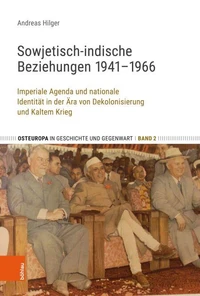Internationale Geschichte seit 1945
Par :Formats :
Disponible dans votre compte client Decitre ou Furet du Nord dès validation de votre commande. Le format PDF est :
- Compatible avec une lecture sur My Vivlio (smartphone, tablette, ordinateur)
- Compatible avec une lecture sur liseuses Vivlio
- Pour les liseuses autres que Vivlio, vous devez utiliser le logiciel Adobe Digital Edition. Non compatible avec la lecture sur les liseuses Kindle, Remarkable et Sony
 , qui est-ce ?
, qui est-ce ?Notre partenaire de plateforme de lecture numérique où vous retrouverez l'ensemble de vos ebooks gratuitement
Pour en savoir plus sur nos ebooks, consultez notre aide en ligne ici
- Nombre de pages325
- FormatPDF
- ISBN978-3-17-032772-6
- EAN9783170327726
- Date de parution23/06/2021
- Protection num.Digital Watermarking
- Taille5 Mo
- Infos supplémentairespdf
- ÉditeurKohlhammer
Résumé
International history since 1945 has been characterized by a constant increase in the numbers of major protagonists involved. In addition to governments and international organizations, independence movements, nongovernmental organizations, and multinational corporations, among others, have influenced global events. The diversity of the protagonists involved is matched by a multitude of contradictory narratives of international history.
The various images of history are also determined by changes in media culture. For the period from World War II to the mid-2010s, Andreas Hilger provides a concise overview of the essential, often conflict-ridden international developments and the forces behind them. Case studies & of photographic icons and memorial parks, for example & illustrate the contradictory nature of memory and the way in which it is shaped by the media in global society and politics.
The various images of history are also determined by changes in media culture. For the period from World War II to the mid-2010s, Andreas Hilger provides a concise overview of the essential, often conflict-ridden international developments and the forces behind them. Case studies & of photographic icons and memorial parks, for example & illustrate the contradictory nature of memory and the way in which it is shaped by the media in global society and politics.
International history since 1945 has been characterized by a constant increase in the numbers of major protagonists involved. In addition to governments and international organizations, independence movements, nongovernmental organizations, and multinational corporations, among others, have influenced global events. The diversity of the protagonists involved is matched by a multitude of contradictory narratives of international history.
The various images of history are also determined by changes in media culture. For the period from World War II to the mid-2010s, Andreas Hilger provides a concise overview of the essential, often conflict-ridden international developments and the forces behind them. Case studies & of photographic icons and memorial parks, for example & illustrate the contradictory nature of memory and the way in which it is shaped by the media in global society and politics.
The various images of history are also determined by changes in media culture. For the period from World War II to the mid-2010s, Andreas Hilger provides a concise overview of the essential, often conflict-ridden international developments and the forces behind them. Case studies & of photographic icons and memorial parks, for example & illustrate the contradictory nature of memory and the way in which it is shaped by the media in global society and politics.



